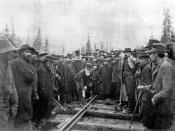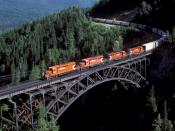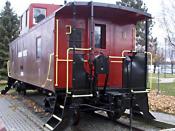The building of the Canadian Pacific Railway, an immense expensive and challenging project, demonstrates the uniqueness of the Canadian way of life. The railroad played an essential role in connecting such a vast land as Canada. It brought together various cultures, connected the dispersed population, and protected Canada's unique political system.
The CPR was a great contributor to Canada's multiculturalism. With the construction of the CPR, Canada did not have enough workers to complete the job; therefore, people from other countries came to help. Many Americans looking for work came to Canada to work on the CPR, as well as many people from the European countries. At one point during the construction of the CPR, two-thirds of the 9000 workers were Chinese. Although religious intolerance, racial discrimination and political indifferences persecuted immigrants working for the CPR, they persevered and established strong ethnic communities that are still found in the major cities touched by the CPR.
Economically the Canadian Pacific Railway is the backbone to Canada. One of the conditions of British Columbia's entry into confederation in 1871 was that a railway had to be built to connect the East Coast of Canada to the West Coast. To do this, a 5000-kilometer line was built through some of Canada's harshest terrain. After many difficulties, a political scandal, and lots of work, the CPR was completed. On November 7, 1885, five years ahead of schedule, the last spike was driven in at Craigellachie, British Columbia and the confederation of Canada was consolidated. The CPR was ready to begin its transcontinental transportation service. As the only passenger service to many isolated communities, and the producer of Canada's many railway towns, the CPR not only linked Canada's provinces but also its diverse ways of life. Fishing villages, mining cities, and farmlands, the CPR...


